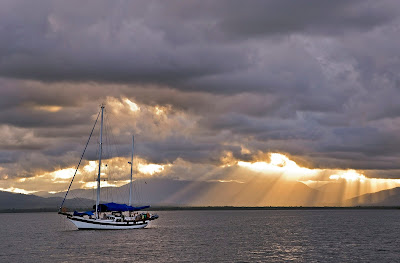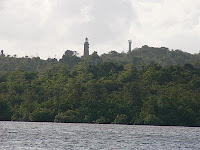Well it has been a while since I have updated the blog. But having just returned from climbing
Mount Kinabalu for the second time it is better to use my fingers to work the keyboard rather than use my legs for anything else.
 |
| Mark and Walt still fit |
All in all it was a good trip. But if I left it at that it would not do it justice. I first climbed the mountain a little over 11 years ago with Pauline before we were married and my sister Chris and her husband Tom. Most of us struggled on that trip, though Tom made it seem a bit easy. My target this time was to first, make it again, second, not hurt myself too bad in the process, third, try to make it before sunrise and fourth, to make sure my climbing companion Walter made it up in one piece. Walt just turned 70 and though he is a fit 70 year old, his body was going to take some abuse.
The plan this time was to make it a three night four day trip. This meant one afternoon and night up at park headquarters near the start of the climb to get our lungs a little used to the lighter air. One day climb up the mountain most of the way to the guest house, Laban Rata, stay there until 02:30 hours the next morning and then climb to the top. Come down after the climb to Laban Rata again, eat lunch, Tiger Balm the legs and sleep and recuperate at Laban Rata for one more night. Return to park headquarters the next morning. Most people make it a two nights and three days trip which means one night at the park headquarters and one night at Laban Rata. There are those other poorly advised people, like us last time, that come up from sea level and try and do it in two days and one night. So let’s just say one good thing that usually comes with age is wisdom. If it hurt the first time there must be a better way!
 |
| First wildlife |
Our accommodation at the park was quite nice and we took the chance to walk to the restaurant for dinner and then back to the room rather than use the transport service to get a small light weight workout prior to our morning start. We also took in a video show and trip briefing before retiring for the night as well as seeing our first wild life - a pinching beetle!
 |
| Walt and Luke |
The next morning we were up at 6 am to hit the breakfast for 7 and meet with our guide a 7:30. Our guide was Luke and believe me, both Walt and I think he is the wonder guide of the year. We were on our way just before 8.
The scenery along the first 6 km walk up to Laban Rata is very interesting and sometimes pretty. But you get so caught up in the effort of climbing that you miss out on the pictures. Of course the problem with this trip is there is no way pictures can really do it justice but we took some to try whenever we could.
 |
| Carson Falls |
 |
| Flowers |
 |
| Walt and Carson Falls |
 |
| Mountain squirrels |
 |
| Bridges |
 |
| Steps |
 |
| Trees thinning out |
As you climb you move from tropical rain forest to thinning forest to sub alpine then alpine and I guess finally barren tundra. All in, it is a little over 8.7 km walk to
Lows Peak which is the highest of several peaks on
Mount Kinabalu. It comes in at 4095.2 metres high which is 13,433 feet or over 2.5 miles up! It is often called the strangest mountain as it does not make sense.
Borneo is geologically pretty stable. Most mountains are created by being at the edge of a subterranean plate where either the force of that plate against another or some volcanic activity made it grow. But Borneo is nowhere near any plates and other than Poring
Hot springs there seems to be no thermal activity in the vicinity. And it is still growing about 5 mm a year. Also Kinabalu is made up of ganodiorite, similar to granite, which is different than most volcanic structures. Kinabalu is a relatively young mountain only about 10 million years. Even older than Walter and my combined ages but young in mountain terms. It receives a huge amount of rainfall around 24 metres per year so things grow. Even in the crags near the summit you find plants. Some of the trees near the top are only dwarf scrub but the same species further down the hill grows well above twenty metres.
 |
| Walt in Poncho in rain |
Anyway back to our climb. As we got higher and our legs more tired our rest stops became more frequent. The rain came early that day and by 10:30 we had our ponchos on.
But we finally made Laban Rata just before the 6 km mark and 3270 metres up ( 2 miles for those North American folk). We were pre warned that the guest house had a generator failure which meant no hot water or heaters. With the outside temp at 10 degrees C or around 50 F it was cool!
We tried to get some sleep but were a bit wired from the trip. And basically just changed and hung out until dinner time. Our guide arranged to meet us for a 2:30 departure and after dinner we retired hoping to catch a few winks before waking up. Walt made me promise that when I got the chance for me to head up with the front climbers to make sure I made it for the sunrise. He said if I hung back he would be tempted to push too hard. So that was the plan and I left him and Luke just before the 7 km mark. After 7 km the terrain becomes what I called tundra. Now you are basically following ropes. Sometimes just to make sure you do not fall. It is a long way down way up there. Most of the time as long as you are taking baby steps you can walk it but there are a few locations where the rope is essential.
 |
| Mark at the summit |
At the 8 km mark one of the guides warned us to take a break. This was because the peak itself was near freezing and we were a bit more protected here. But after what seemed like only seconds we were advised to get moving or we would miss the sunrise. By the time we hit the 8.5 km mark I am sure there were some light snowflakes swirling around my head lamp. I mentioned it to some of the others and they said maybe just light rain. But then they agreed it must be some frosty thing or another. Luckily it was not heavy and vanishing before it hit the ground.
Lows Peak is the highest of all the Peaks and this is the one that we needed to climb to get our certificate. I made it up just before 5:30 and sunrise was scheduled for 5:40. We didn’t get a clear sunrise as there was some cloud cover to the east. But I had a clear view of the lights below in Kota Kinabalu and had earlier seen the lights of
Sandakan.

 |
| Sunrise |

The top of the peak is pretty crowded and I had told Walt I would wait for him at the base. I was a bit worried he wasn’t going to make it as his knee was giving him some problems. But when I got down from Lows someone asked me where Walt was and I said I wasn’t sure if he would make it but I was to wait for him here. Then someone else said there he is and sure enough slow and steady he was there. I asked if he wanted me to go back up with him and he said that it wasn’t required. But after a few minutes watching him I decided to head up again and give him moral support. He made it to the top sometime after 6:30. And this time it was a bit warmer and brighter and I could get some better pics.
 |
| Victoria Peak |
 |
| Top of South Peak |
 |
| St John's Peak |
 |
| Walt at the top |
 |
| We made it |
Going down, we were both glad we opted for an extra night at Laban Rata. Though there was no heat at least we could Tiger Balm up our legs and get rested before the final descent. That night we got the mother of all storms. Many of the people we met during the day who were scheduled to climb the next morning didn’t make it. There were stories of knee high streams that they had to travel through. About 3 metre visibility and thus no scenery. The winds were shaking the guest house and rattling the windows so I am sure the poor climbers out on the mountain were suffering. We stayed tucked in our beds until 7:00 and awoke to it still raining but at least the winds had dropped off. A waterfall was screaming past outside the rest house window where the stream usually flows. I tried taking a picture through the window but my camera really wasn’t up to it.
 |
| Walt's broken shoe |
 |
| Better photo of it |
At 8:00, though it was still raining and awful cold, we headed out the door. We had gotten about a kilometer when Walt’s shoe had a blowout. He had some string and I had some dental floss and we made repairs every few hundred metres. I then came up with the idea that after we tied it up we could fit one of my socks over the boot to hold it in place. This worked for about two kilometers until the sock wore through but we now knew we had the means so we fixed it again at the two kilometer mark and it made it all the way back to the marina.
 |
| 10 steps to go |
We finally made it back to Timpohon Gate just after 2pm and we were all smiles.
 |
| Almost there |
 |
| Luke, you did your job |
 |
| Laban Rata, as seen from the Park headquarters. White dots between the cloud line and the towers |








































































